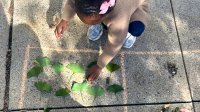Fall Math Manipulatives: Pumpkins, Leaves, and More
Students can get hands-on by incorporating natural objects into curiosity-driven math lessons like measuring and sorting.
Your content has been saved!
Go to My Saved Content.Autumn: the time of year when apples, pumpkins, and colorful leaves fill every classroom. But while these fall staples are often presented as images on worksheets, the season is also an opportunity to incorporate the real things into math activities. Nature itself provides the manipulatives and materials for young learners to develop foundational mathematical practices while exploring in an organic and meaningful way.
6 Ways to Incorporate Fall in Your Math Classes
1. Measuring: How can you measure a pumpkin? Ask kindergarten students this question and you’ll get a lively discussion. For a measurement unit, place students in groups of three and give each group a different-sized pumpkin to explore. Encourage them to discuss the sizes and use comparison vocabulary—words like taller, bigger, smaller, and heavier. After giving students time to follow their curiosity, ask them to determine how to measure their pumpkin. You can provide students with a variety of materials to choose from, such as connecting cubes, linking chains, rulers, and small counting figures, which they can explore and test before deciding what they want to use.
Groups measure around the pumpkin and stack items next to it to find its height, and then discuss which manipulatives worked best for measuring. When students share their findings, ask them about the need for a common measuring unit to be able to compare all the pumpkin measurements—a need they often discover on their own.
Mathematical practices highlighted: 5 and 6
2. Sorting and Categorizing: Fall is a beautiful time to go on a nature walk with students. When exploring the outdoors, we collect appropriate materials (nothing unsanitary!), and students are excited to analyze and examine what they find. After spending time sharing what they collected, ask students to work in groups to sort the items into different categories. In doing so, they have to justify their thinking and convince others where items should go. Categories created by students often include color, size, material, and how many points each leaf had, among others.
This is an exercise that can be adapted to meet the needs of a variety of age groups. Younger students might sort items into two categories, while older learners can try to generate more. Listening to students discuss their selections and then encouraging them to try to find another way to sort the items is a rich mathematical task.
Mathematics practices highlighted: 2 and 3
3. Comparing Lengths: Dried flowers and grasses provide the materials for this activity, which allows students to practice comparing a set of items with various lengths. Students use terms such as short, shorter, and shortest as they place their items in order. This also provides a natural opportunity to share and discuss how we measure items by length. Without too much prompting, students discover that in order to compare items’ lengths, they need to line up the items with a common starting point.
Mathematics practices highlighted: 3 and 6
4. Patterns: The book Alma’s Art, written by Roda Ahmed and illustrated by Anita Cheung, tells the story of the artist Alma Thomas as a young girl discovering new art materials and creating new patterns. The book can prompt students to notice and wonder about different colorful patterns. Reusing the natural materials from our nature walk, we create patterns, and students talk with a classmate to determine what items would come next. Then, after some time exploring, students generate their own patterns and can have classmates work to extend the patterns. Autumn colors can be added to create an art project, such as a print made with apples or other fall items.
Mathematical practices highlighted: 7 and 8
5. Counting Collections: An important goal in early childhood math is building number sense. One way to do this is to engage in counting collections, which allows students to problem-solve in small groups and determine how to count, organize, and record their thinking with a large amount of items. Working in groups is key here, as it allows children to take risks, share ideas, and build on each other’s thinking.
You can kick off this activity by reading a fall-themed picture book, such as Counting on Fall, by Lizann Flatt and illustrated by Ashley Barron, before allowing students to visit different stations with containers of various items to count and organize. For a fun fall twist, consider using leaves, acorns, or pine cones as counters.
Mathematical practices highlighted: 1, 6, and 7
6. Number formation: Recognizing and forming numbers 1–10 is a common goal in kindergarten. This task can often feel tedious and bland, but by working with tactile, natural materials, children can build their muscle memory for number formation in a fun and engaging way.
Present children with natural fall elements that contain both straight and curved lines. With numbers 1–10 as a reference, have them create the numbers with the materials. Items like sticks can be used to make straight numbers, while pine cones can represent the circles and curves found in the numbers 6 and 9. Children can use acorns to create the curves in the number 5 and find countless other ways to use leaves, pumpkin seeds, and pine needles. Once the numbers are created, students can present stick-made ten frames, model the numbers, and compare them with their table partners’ numbers.
Mathematical practice highlighted: 4
